Table of Contents
Table of Contents
When considering equipment for a new business video security system, one of the primary elements that often comes to mind is commercial security cameras. However, it’s important to note that these cameras are just one part of a comprehensive security infrastructure. By focusing on the entire business video security system, you can enhance both the level of security and the return on your investment in security cameras.
In this article, we look into the concept of business video security systems, their components, and the reasons why they are essential. We begin by providing a definition and outlining the various elements of the system. Then, we present a practical case study that demonstrates the process of constructing a business video security system based on a business floor plan.
See how Solink’s business video security system completes your company’s security infrastructure.
Learn how Solink can support your business.
What are business video security systems?
The concept of a business video security system encompasses the entirety of the business security ecosystem. It includes not only the commercial security cameras themselves but also the complete array of hardware and software components that work together to optimize the effectiveness of these cameras.
What are the components of a business video security system?
There are four main components of a commercial video security system:
- Business video security cameras
- Data storage
- Cloud connectivity
- Video analytics
Commercial video security cameras
Video security cameras serve as the foundation of the system. They are essential for most commercial sites, including offices, restaurants, and stores. However, solely acquiring video security cameras for your business would result in an incomplete and underutilized security infrastructure.
Data storage
While certain cameras offer built-in data storage, it tends to be limited in capacity. Alternatively, some cameras have the ability to transmit data directly to the cloud, which can be advantageous if you have sufficient bandwidth and a reliable connection without any downtime.
However, the majority of systems utilize either a DVR (digital video recorder) or NVR (network video recorder) system as the primary storage device for your data.
These systems can be tailored to suit the particular video retention requirements of your commercial establishment. Whether you need 15, 30, 90, or an extended period of on-site video storage, Solink can cater to your specific needs.
Cloud connectivity
Incorporating cloud-based video security enhances the functionality of your business video security system by offering various advantages. It facilitates remote backup and enables remote access to your video security camera feeds, among other benefits that significantly enhance user efficiency.
For instance, Solink provides automatic software updates for all of our systems. Additionally, we conduct automated security camera health checks to promptly notify you if any of your cameras have gone offline or are obstructed in any manner.
AI video analytics platform
Video analytics refers to the automated interpretation of video footage to detect and identify spatial or temporal events, ideally in real time. It plays a crucial role in a contemporary commercial security system, as security cameras offer valuable data that can be utilized for purposes beyond surveillance.
Merely collecting and storing this data without leveraging it can make business decision-making more challenging. Here are a few examples of how Solink’s AI video analytics platform can assist you.
Security related:
- Match video clips to high-risk transactions (voids, cash refunds, high discounts, zero-dollar transactions, and no-sale till opens) by integrating security cameras with your point of sale (POS) system.
- Utilize motion search to see all activity in an area to quickly track down shoplifters.
- Use Solink Video Alarms Monitoring Service to create time-based perimeter defenses, protecting your property when you aren’t there.
- Receive proactive alerts when specific transactions, items, or criteria are met with Threshold Notifications.
- Be notified when someone enters a restricted area.
Non-security related:
- Audit your stores for regulatory and company policy compliance (e.g., make sure emergency exits are cleared and stores are clean).
- Modify your store layout based on customer heat maps to improve merchandising.
- Use your video security cameras as a people counting tool to unlock needed metrics including average guest value or conversion rates.
- Perform case management functions for events such as slip-and-falls.
- Enhance drive-thru speed of service to improve customer experience and hourly revenue.
To see how Solink can help you get the most out of your video security cameras, request a demo today.
Why do you need a business video security system?
Business video security systems offer a range of benefits to your enterprise. Here are just a few examples of what you can expect to gain from implementing such a system:
- Reduce inventory shrinkage
- Remote video security
- Optimize operations
- Better staff training
- Real-time video monitoring
Reduce inventory shrinkage
With well-positioned cameras and an AI video analytics platform, you gain the capability to rapidly scan through an entire day’s worth of video footage within minutes. This invaluable feature enables you to identify various forms of inventory shrinkage, including employee theft, shoplifting incidents, organized retail crime (ORC), and instances of merchandise disappearing or being taken from the loading dock.
Remote video security
Remote video monitoring provides a substantial value-add to your business. The ability to monitor all of your locations from your corporate head office or even from the comfort of your home on your laptop or mobile device grants you enhanced control over the day-to-day operations of all your sites.
Furthermore, certain companies take remote video monitoring a step further, implementing a practice known as virtual guarding. In this approach, on-site security guards are replaced by live video security. This not only improves the overall security level of your enterprise but also leads to significant cost reductions.
Enhance safety
Amidst a recent rise in violent crime, prioritizing the safety of your people, patrons, and profits has become increasingly important. Implementing an integrated and monitored video security system designed for business not only helps safeguard against violent incidents but also provides protection in various other scenarios.
By conducting remote audits for both company policies and regulatory compliance, you can ensure the adherence to safety measures such as keeping emergency exits clear, deploying wet floor signs to prevent slip-and-fall accidents, and preventing unauthorized access to restricted areas by visitors. This comprehensive approach helps create a safer environment while maintaining compliance with necessary regulations.
Optimize operations
Business video cloud video security cameras offer numerous ways to optimize store operations. Let’s explore two examples.
First, heat maps generated automatically with AI video analytics from your store’s security footage can assist with merchandising strategies by identifying optimal product placement locations that drive revenue. By strategically positioning high-demand items in the right areas, you can maximize sales potential.
Second, monitoring employee behavior and customer interactions through video security ensures that your staff actively assists patrons. This proactive approach enhances customer satisfaction and ultimately contributes to increased revenue. These examples underscore the importance of implementing a business video security system for your enterprise.
Better staff training
Whether you aim to enhance your onboarding process or improve ongoing training efforts, your commercial video security system can be a valuable tool. The ability to save video clips to the cloud indefinitely right in the Solink platform offers more than just faster investigations or providing evidence to law enforcement.
For example, if you see employees doing something really great, or questionable, save the clip and use it as part of your onboarding process. When you find patterns of employee misconduct, showing the video during the one-on-one meeting with the employee can make it more impactful.
Real-time video monitoring
Certain events carry a high level of risk and are difficult to search for retrospectively. By implementing Solink Video Alarms, you can receive alerts when motion is detected outside of normal business hours. This allows you to promptly view the real-time situation before deciding whether to dispatch emergency responders. This proactive approach enhances perimeter security while minimizing the risk of fines resulting from false alarms.
Moreover, motion alerts can notify you when someone enters a sensitive area of your property, even during working hours. This feature adds an extra layer of security. If your enterprise stores valuable assets outdoors, such as a dealership or DIY center, video alarms prove more practical than standard panel alarms that solely protect doors and windows.
Additionally, for transaction types with a higher risk of fraud, you can receive notifications when such transactions occur. This enables you to immediately review the associated video footage. Furthermore, you have the ability to set thresholds and receive alerts when key metrics deviate from your desired range. For instance, you can be notified if the average drive-thru speed of service exceeds your predefined limits.
These features provided by Solink enhance security, enable quick response, and help you maintain control over critical aspects of your business operations.
Document events
Video retention serves as a crucial component of business video security systems for various reasons. By storing video footage of specific events indefinitely in the cloud, you can significantly improve your case management process. The Solink platform allows you to effortlessly send footage of these events directly to managers, insurance companies, law enforcement, or any designated email address.
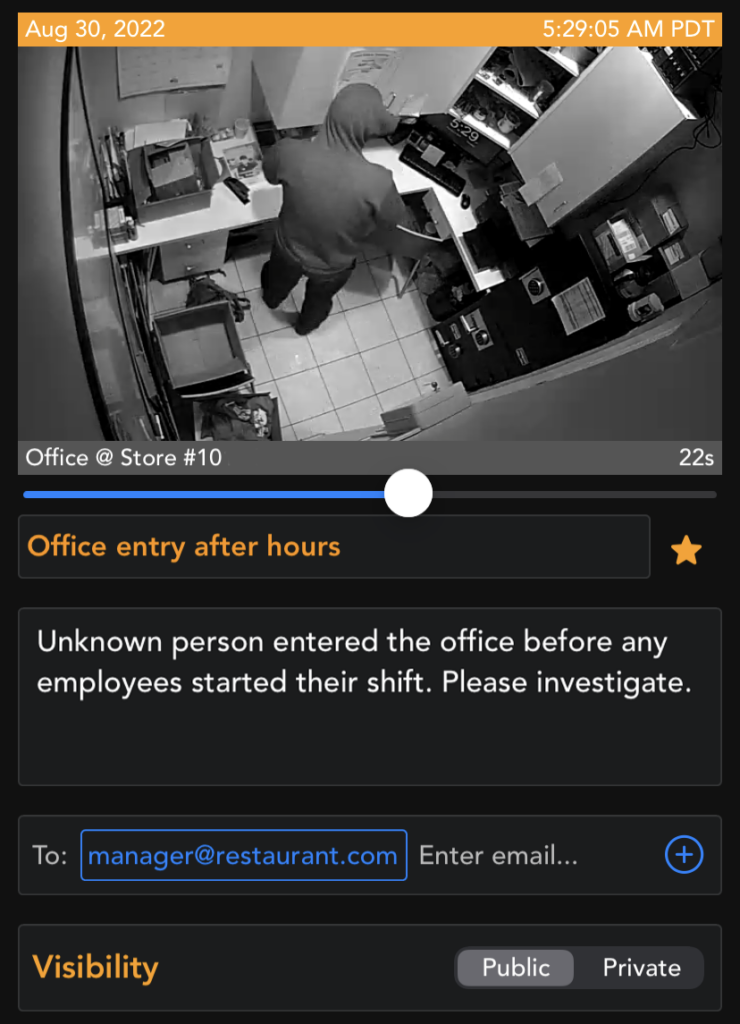
For instance, a bank can utilize Solink to capture evidence of an ATM attack, which can then be forwarded to the police for investigation and to the insurance company to expedite the payment for repairing the damaged ATM wall, by email within the platform.
Furthermore, saving footage of events can contribute to enhancing different aspects of your enterprise. As mentioned above, video evidence of employee theft can be utilized as part of your loss prevention onboarding training. Conversely, you can capture footage of employees delivering exceptional customer service, allowing you to acknowledge and praise their efforts during your next staff meeting.
By leveraging the capabilities of video retention, you can streamline case management processes, strengthen training initiatives, and improve overall operational efficiency within your organization.
What are the main types of video security cameras for business?
There are many different types of video security cameras for business. Let’s break down all the specific definitions.
If any of your current cameras are offline, here are some help security camera troubleshooting tips.
Bullet cameras are some of the most common video security cameras available in the market. These cameras derive their name from their streamlined shape and compact size.
Their compact form and straightforward installation process render them highly versatile. Bullet cameras can be employed both indoors and outdoors, and their relatively smaller size often makes them less conspicuous compared to larger security cameras like turret cameras (which are discussed next). It is worth noting, however, that they are more vulnerable to vandalism when compared to dome cameras.
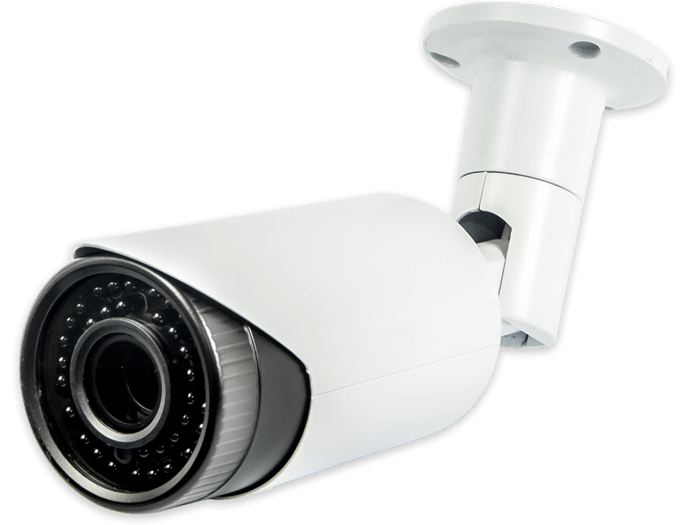
Turret security cameras feature a unique ball-and-socket design. Within the “turret,” the camera is situated on a movable ball mechanism, allowing it to be positioned at various angles.
This design offers flexibility during installation and re-positioning of the camera. However, it’s important to note that once the camera is installed, physically adjusting its position is necessary to achieve a new field of view.
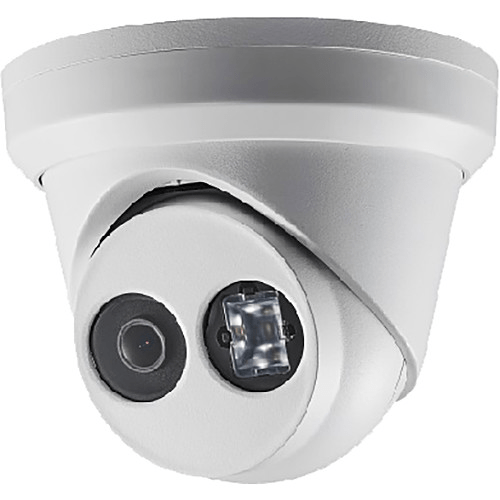
Dome cameras are characterized by their distinctive design, featuring a protective dome covering. This enclosure obscures the exact direction in which the camera is facing, creating a level of uncertainty for both employees and customers regarding its field of view.
In addition, their shape and protective dome casing make dome cameras more resilient against acts of vandalism.
However, similar to the other cameras mentioned above, dome cameras have a fixed viewing angle that cannot be adjusted remotely.
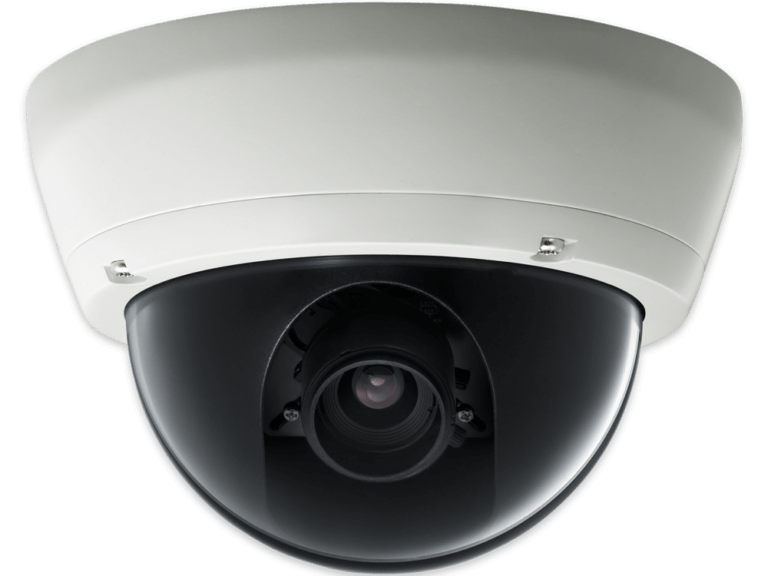
PTZ stands for pan, tilt, zoom, which exactly describes the capabilities of PTZ security cameras. These cameras can be remotely controlled to pan across a wider area, tilt the viewing angle up and down, or zoom in on specific targets.
The additional functionality provided by PTZ cameras typically comes with a higher price tag. However, it may be possible to offset this cost by using fewer security cameras in total due to their ability to cover larger areas.
It’s important to note, however, that PTZ cameras only record what the lens is currently facing, unlike the 360 degree cameras discussed next. Moreover, since the pan, tilt, and zoom features of PTZ cameras rely on mechanical components, there is a chance that they may experience malfunctions or operational issues.
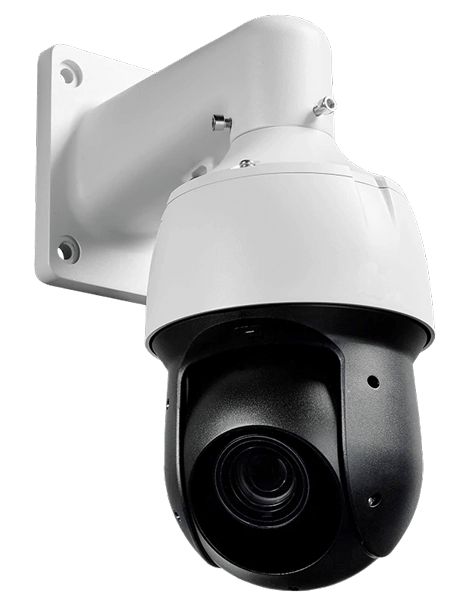
Fisheye cameras can be seen as a further advancement in the realm of video security cameras for business. While PTZ cameras improve upon turret cameras by allowing remote adjustment of the viewing angle, 360 cameras take it a step further by providing a complete 360° by 180° view at all times.
This makes them highly suitable for monitoring large open areas, such as the dining area of a restaurant or the produce section of a grocery store. In fact, in these locations, a single fisheye camera can replace up to six standard security cameras, more than offsetting their higher price tag.
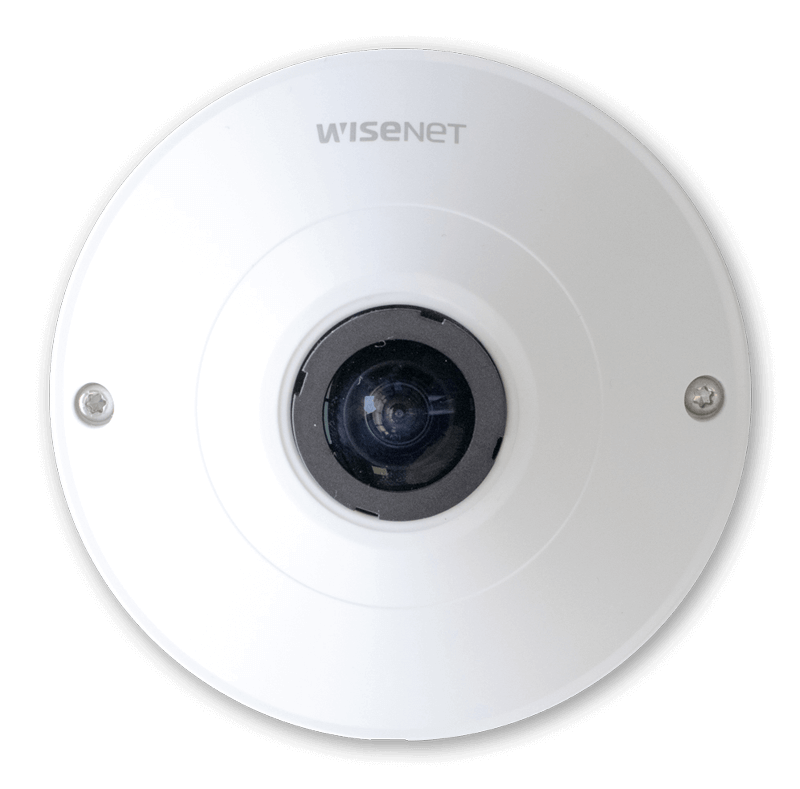
Fisheye cameras are colloquially referred to as such due to the distorted image they produce, resembling the view through a fisheye lens. However, Solink utilizes modern gaming technology to stretch and enhance this view, providing users with an immersive and comprehensive perspective of activities occurring at their sites.
Here’s the 360 camera at work within Solink:
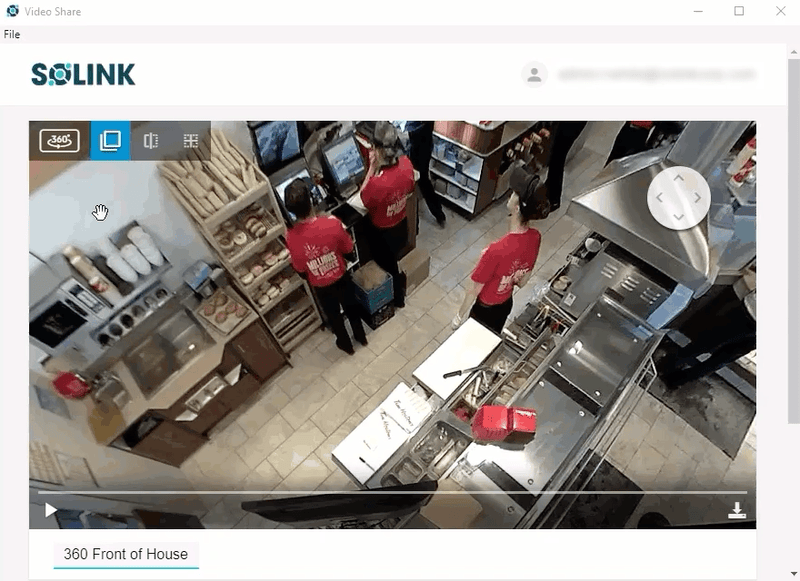
Learn how Solink can support your business.
Commercial video security camera comparisons
Business video security systems are complex infrastructure. Many decisions need to be made on the components, which can affect the cost, required maintenance, and functionality.
Here’s a list of common comparison points.
WiFi vs. Ethernet

When comparing WiFi and Ethernet, it’s important to note that WiFi security cameras transmit data wirelessly, while Ethernet cameras utilize wired transmission. However, both types of cameras require a power source to function, with WiFi cameras typically being plugged into a socket for energy.
On the other hand, Power over Ethernet (PoE) technology combines power and data transmission in a single Cat 5 Ethernet cable. This means that, just like their WiFi counterparts, PoE security cameras typically have a single wired connection. That’s because WiFi security cameras, unless they are battery- or solar-powered, still have a single wired connection to the power grid.
While WiFi is generally resilient to noise interference, it is inherently slower, less robust, and less secure compared to Ethernet. WiFi signals also have limited range, with reliable video transmission becoming challenging beyond approximately 50 feet/15 meters. The effective range can be even shorter depending on the number and type of obstacles between the router and the cameras.
In contrast, Ethernet cables used for IP security cameras can reliably transmit data over distances exceeding 300 feet/90 meters.
NAS vs. cloud video storage

When considering storage options for your business video security system, the choice between local storage and cloud storage is often best answered with a combination of both. This entails utilizing local storage for immediate access and incorporating cloud backup storage for added security and data redundancy.
Local storage options can be categorized into using an NVR/DVR appliance, utilizing built-in camera storage, or implementing network attached storage (NAS) solutions.
Cloud-based storage relies on a continuous and reliable Internet connection, which may not always be feasible in certain situations. However, storing data in the cloud offers the advantage of accessing video footage from anywhere.
Solink provides a cloud-based video security solution that includes a hand-off, fully warranted NAS appliance, ensuring seamless data management and accessibility. This hybrid approach combines the benefits of local storage with the convenience and flexibility of cloud-based storage.
SD vs. HD vs. 4K

Standard definition (SD), high definition (HD), and 4K are terms used to describe the resolution at which commercial video security cameras record footage. Traditional analog cameras typically record in standard definition (SD), although there are now some HD analog security cameras available in the market.
In contrast, IP cameras, which are digital cameras connected to a network, generally offer at least high definition (HD) resolution and often provide 4K resolution. These higher-resolution IP cameras offer greater clarity and detail in the captured video footage.
Perform remote monitoring
Resolution refers to how many pixels are recorded in an image. Here’s a summary of the different resolutions:
- SD usually refers to resolutions below 720 × 480 pixels.
- HD usually refers to 1280 × 720 or 1920 × 1080 pixels.
- 4K refers to 3840 × 2160 to 4096 × 2160 pixels.
Pixels are the small colored dots that make up the image captured by a camera, and a higher number of pixels means the dots are closer together, resulting in greater detail and clarity. While higher resolution can often be advantageous, there are several other factors to consider when making decisions about camera resolution.
Bandwidth
Bandwidth refers to the speed of your Internet connection. Higher video resolution requires more bandwidth to transmit.
The following chart displays the recommended bandwidth levels for different video resolutions.
| Video resolution | Average bandwidth use for simultaneous viewing (at 10 fps) * |
| 720 × 480 | 0.75 Mbps per camera |
| 1280 × 720 | 1.5 Mbps per camera |
| 1920 × 1080 | 2 Mbps per camera |
| 3840 × 2160 | 8 Mbps per camera |
| 4096 × 2160 | 10 Mbps per camera |
When multiple cameras are streaming to the cloud, the bandwidth requirements for 4K resolution can quickly surpass the capacity of your Internet connection. This is precisely why Solink employs a strategy of simultaneously recording multiple resolution streams and storing the data locally.
By adopting this approach, users can instantly view the standard definition (SD) stream without any delay and access the high-definition (HD) stream with a short buffering delay. This eliminates the need to send all security camera feeds to the cloud simultaneously.
Nevertheless, remote access to all video footage is still available, and Solink easily accommodates higher resolutions when required. This dual feed system effectively removes the conventional tradeoff between quality and functionality, allowing users to benefit from both fast-loading SD streams and high-quality HD streams.
Frame rate
Frame rate refers to the number of frames per second (FPS). If you think of a video stream as a series of still pictures, FPS is the number of pictures shown per second. More pictures will make a smoother, more detailed video. However, a higher FPS will also require more storage capacity to save the video and bandwidth to transmit it.
Frame rate and resolution combined dictate your bandwidth and video storage needs.
Field of view
A camera’s field of view (FOV) refers to the angle width (and height) that it captures in its recorded footage. In the realm of commercial video security cameras, there is a wide range of available FOVs. Smaller, zoomed-in cameras may have a FOV as low as 40°, while fisheye security cameras can achieve a wide FOV of 360° by 180°.
The combination of FOV and resolution directly impacts the final quality of the captured video. With the same resolution, a camera with a smaller field of view will typically exhibit more details than a camera with a larger angle.
This is why 360 cameras often feature higher resolutions compared to other types of security cameras. This increased resolution compensates for the wider FOV, allowing for greater clarity and detail in the captured footage
IP cameras vs. analog cameras

IP security cameras record and transmit storage digitally. While many analog cameras can still connect to Solink’s cloud video management system, it is not recommended to install new analog cameras as this is an obsolete technology.
IP cameras vs. cloud cameras

Recently, a newer technology has been released on the market. Cloud-based security cameras come in two varieties. The first type are designed specifically for cloud video security but still transmit their data through local storage. The second type transmits footage directly to the cloud.
This latter type has become popular for residential security systems that typically have few cameras and lower video quality, as well as lower security demands. However, for large commercial video security needs, it is still currently recommended that you build systems with local storage capacity.
Where should you place your business video security cameras?
Placing the cameras on your property is a key step in building a strong commercial video security system. There are many issues you need to keep in mind when doing this in your business.
Here is a complete business video security camera floor plan for a quick service restaurant (QSR) that takes all of these issues into consideration. (Note that this plan is for demonstration purposes only, and all sites have unique security requirements.)
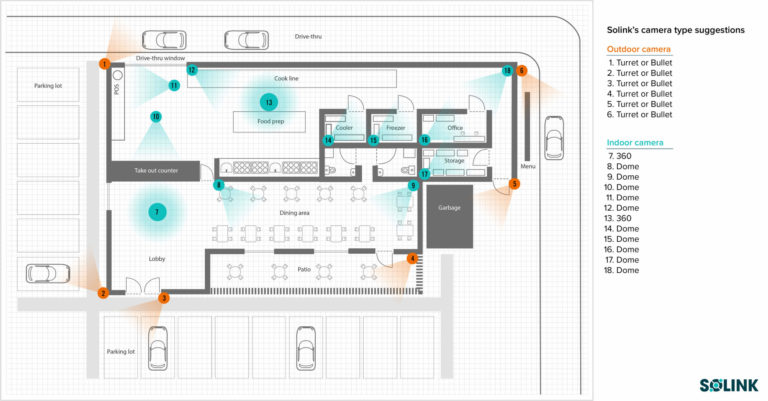
The following table summarizes the camera type, location, and reason for the coverage. The full reasoning behind this commercial video security camera floor plan can be found here.
| Outdoor cameras | |||
| Number | Camera Type | Location | Purpose |
| 1 | Turret or bullet | Drive thru | Monitor drive thru speed of service |
| 2 | Turret or bullet | Walkway/parking lot | Monitor slip-and-falls and traffic |
| 3 | Turret or bullet | Walkway/parking lot | Monitor slip-and-falls and traffic |
| 4 | Turret or bullet | Patio | Protect patrons |
| 5 | Turret or bullet | Backdoor/garbage | Perimeter defense |
| 6 | Turret or bullet | Drive thru | Monitor drive thru speed of service |
| Indoor cameras | |||
| Number | Camera Type | Location | Purpose |
| 7 | 360 | Lobby | Protect patrons |
| 8 | Dome | Dining area | Protect patrons |
| 9 | Dome | Dining area | Protect patrons |
| 10 | Dome | Takeout counter | Monitor delivery services |
| 11 | Dome | POS | Monitor transactions and cash activity |
| 12 | Dome | Cook line | Monitor food safety |
| 13 | 360 | Food prep area | Monitor food safety |
| 14 | Dome | Freezer | Inventory security |
| 15 | Dome | Freezer | Inventory security |
| 16 | Dome | Office | Safe security |
| 17 | Dome | Storage room | Inventory security |
| 18 | Dome | Office entrance/backdoor | Safe security and perimeter defense |
While a single purpose for each security camera is listed in the table, they all serve multiple functions. Outdoors, turret or bullet cameras are typically utilized due to their robust design, which allows them to withstand harsh environmental conditions.
Indoors, a combination of dome cameras and fisheye cameras are commonly employed. Dome cameras offer a similar field of view as turret or bullet cameras, but their direction is hidden, providing an additional layer of security. They are also protected from potential vandals, such as employees attempting to conceal theft or disgruntled customers. On the other hand, 360 cameras are strategically positioned in open areas, such as the lobby and kitchen, to provide comprehensive monitoring coverage with fewer cameras.
By incorporating a mix of camera types in different locations, businesses can optimize their security system to meet various security and operational needs, ensuring comprehensive coverage and safeguarding against potential risks.
Solink completes your business video security system
Solink brings AI video analytics features to video security systems for business:
- Motion and event search saves time during investigations.
- Share evidence with law enforcement by email to simplify case management.
- Camera health checks make sure your security cameras are online and unoccluded.
- Automated security updates protect you from cyberthreats.
- The regular release of new features means the ROI keeps increasing year over year.
This breathes new life into your security cameras and allows for a far greater ROI from expensive infrastructure.
To see how Solink gets the most out of your video security system, sign up for a demo today.

Solink stands at the forefront of security solutions, excelling in loss prevention and asset protection for businesses. Our content is rich in industry expertise and crafted to provide actionable insights and innovative strategies. We empower businesses to enhance their security systems, optimize operations, and protect their assets more effectively. Discover how our advanced cloud video management system can transform your security approach.
